Do you love the taste of fresh peas? If so, you’ll be excited to learn how easy it is to grow your own! In just a few steps, you can have a bounty of delicious peas to enjoy all season long.
Read on for tips on how to get started.
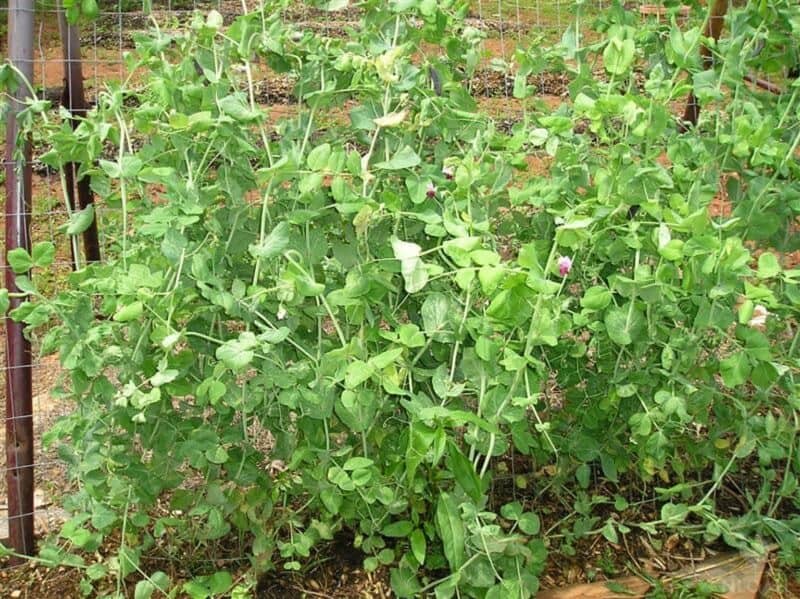
What Are Peas?
Peas are one of the oldest vegetables grown in the United States, and date all the way back to the ancient Greeks and Romans. While they originally were only eaten as a dry good – it used to be believed that green peas were poisonous – today, they are one of America’s most popular vegetables.
Pea pods are a great source of vitamin K, manganese, copper, vitamin C, and fiber, among many other nutrients. They also pack a delectable crunch, making them a good snack for picky little eaters!
There are many different kinds of peas, including bush and climbing varieties. Bush peas are great for first-time pea farmers, with popular choices including Burpeeana Early and Sugar Bon peas. Planting on a trellis can be helpful, too, if you’re low on space.
I’m trying a new variety this year: Wando Garden Peas. They’re supposed to be more heat tolerant than some other varieties, and are well suited to the South. I’m hoping to be able to continue planting them for a few more months, to extend the harvest.
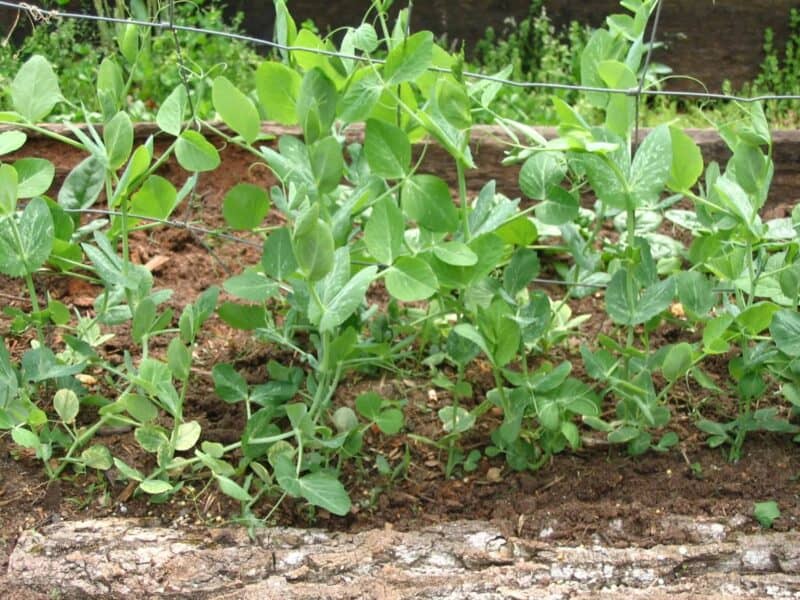
And don’t forget about snow peas! These are some of the best pea varieties for people who have cool springs. Snow peas are a type of pea that is eaten while the plant is still young and the pods are tender. The peas themselves are small and round, and they are encased in a thin, edible pod.
Snow peas are most commonly green, but they can also be found in shades of white, yellow, and purple. When shopping for snow peas, look for bright green pods that are free of brown spots or other blemishes.
While they can be eaten raw or in salads, snow peas are often cooked in stir-fries or soups. When cooked, they have a sweet and slightly crunchy texture.
Another great type of pea with excellent flavor to consider for your vegetable garden are sugar snap peas. Snap peas, like sugar snaps, have a crunchy flavor and reach maturity quickly, meaning you’ll have a harvest in no time.
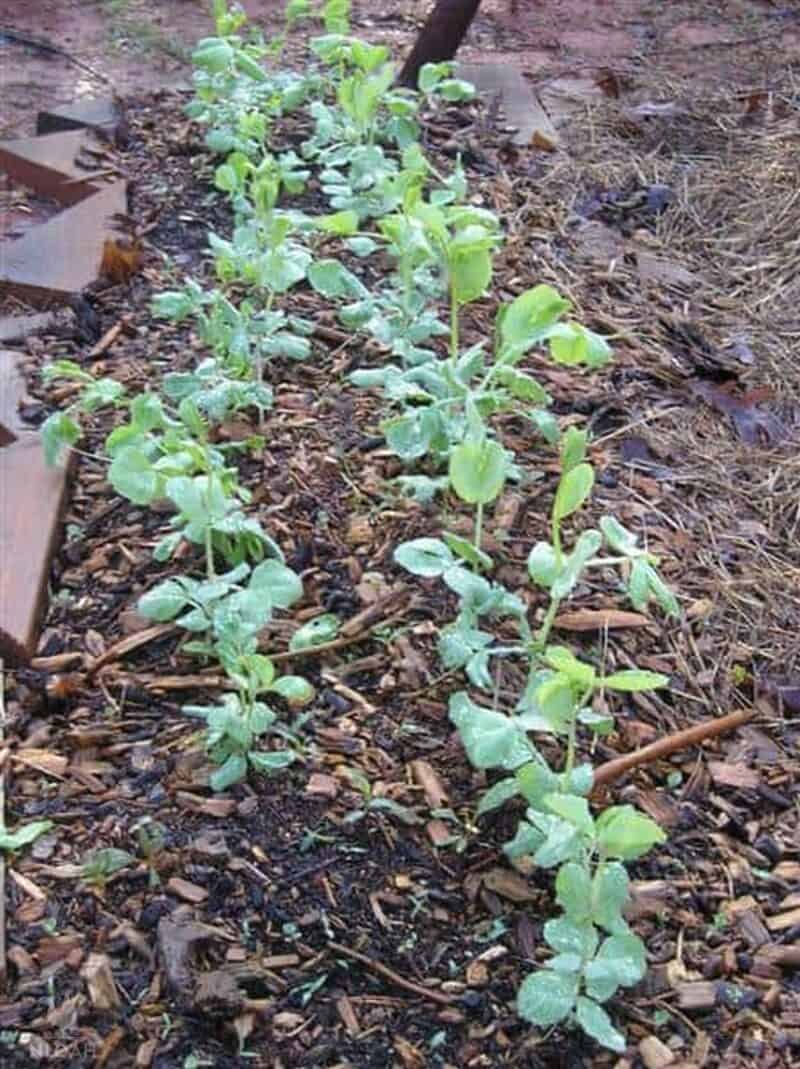
All in all, the veggies in this sweet-tasting plant family are incredibly diverse. From dwarf varieties to pea shoots, heirloom peas to those with purple pods, you’ll have plenty to choose from!
When to Plant Peas
Peas are one of those crops that can be planted in the ground before the last chance of frost, and are one of the first crops I get in the ground in early spring.
Peas are incredibly easy to plant, requiring little attention besides watering and harvesting. They rarely attract pests or develop diseases, and most seeds sold today are marketed as disease-resistant.
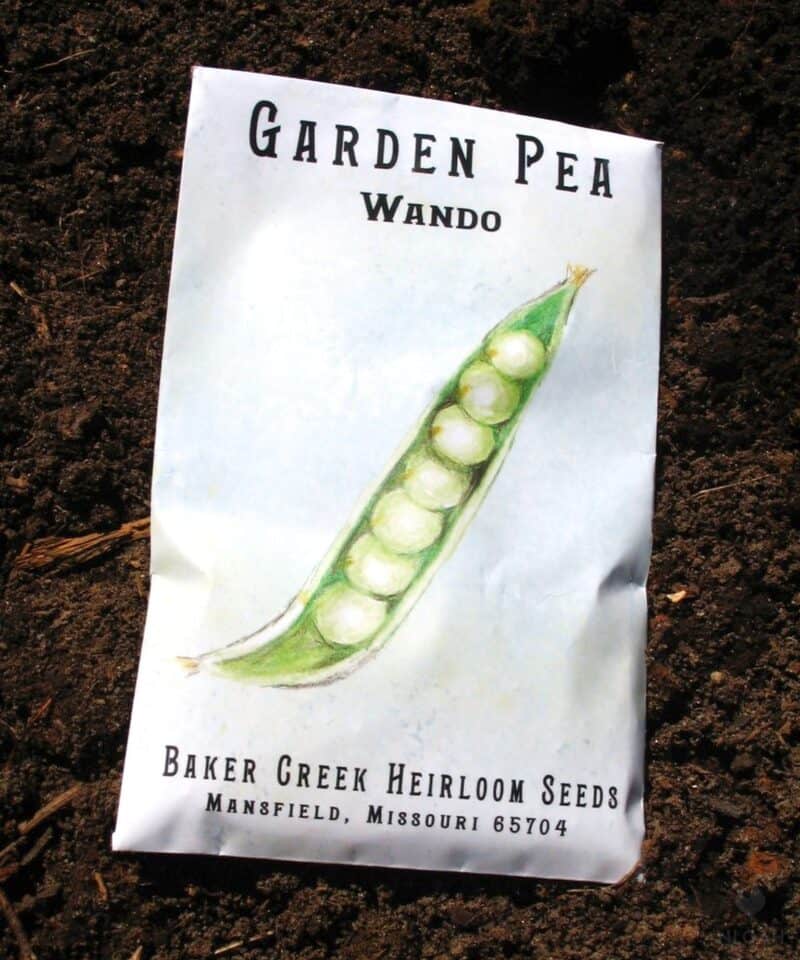
Peas grow best in colder weather, and young plants can even withstand light frosts. As I mentioned, they can be planted early in the spring, as they do well when spring weather turns cold and damp.
That being said, make sure you plant your peas early enough in the spring so that you can get at least one full harvest before summer temperatures grow too hot for these heat-sensitive plants.
If you live in a temperate zone, try to plant in March. In colder climates, plant a month before your last anticipated frost.
If you’re reading this in June and already missed that planting date, don’t fret. Peas can make it through warmer weather, provided that you give them plenty of diligent watering, shade, and mulch until fall arrives.
We planted our peas a week ago today. I thought I’d show you just how easy it really is to grow this delicious, nutritious vegetable..
Planting Peas
Peas can be started indoors to transplant outside later, but their roots don’t usually hold up well to the transplantation process.
Therefore, most people sow seeds directly into the soil. For best yields, consider planting early, mid-season, and late varieties so that you can enjoy a pea harvest throughout the entire growing season.
If you’ve never seen pea seeds, this is what they look like. Essentially, they’re just dried, shriveled up peas.
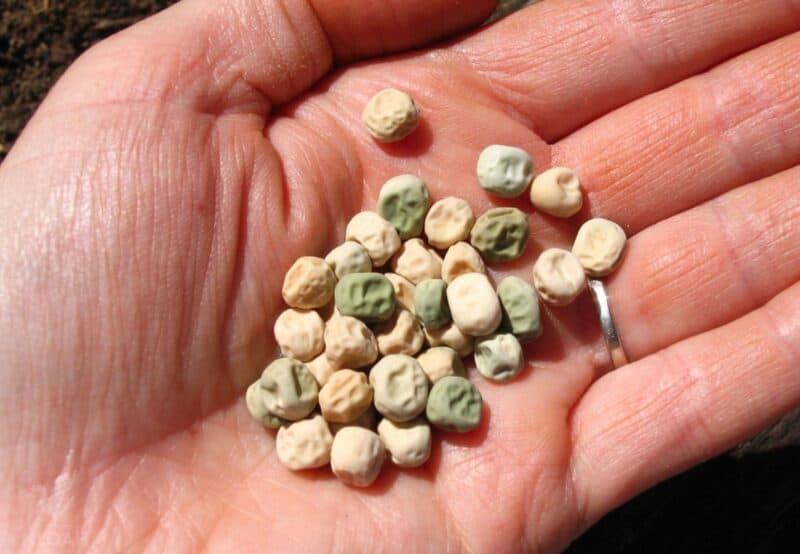
Pea seeds should be planted about two inches apart, and they should be placed about an inch deep in the soil. You will also need to leave enough space between rows of plants so that you can easily access them for harvesting.
Make a furrow along the length of your trellis, between 1/2″ and 1″ deep. Peas prefer fertile, sandy loam, but can tolerate any kind of soil as long as it is workable. Heavy, clay soil can restrict pea roots, while overly acidic soil can also stunt their growth.
Amend your soil a few months before planting if its structure is not ideal. You can do this easily by adding compost, agricultural lime, or dolomite, depending on your needs.
You might consider planting peas in raised beds or containers to help increase yields and provide for better control of moisture and other weather factors.
Sow thickly, placing the pea seeds again, about 2-3″ apart, then cover back over them with a thin layer of soil.
Once seedlings begin to emerge, usually around a week to a month after planting (depending on the temperature), mulch around them with straw or wood chips to help retain moisture in the soil.
This also helps to prevent weeds and discourages the growth of pests and diseases.
Where to Plant Your Peas
Peas are a versatile and delicious addition to any garden, but they can be a bit finicky when it comes to where they are planted.
Peas need full sun and well-drained soil in order to thrive, so it’s important to select a spot that meets those requirements.
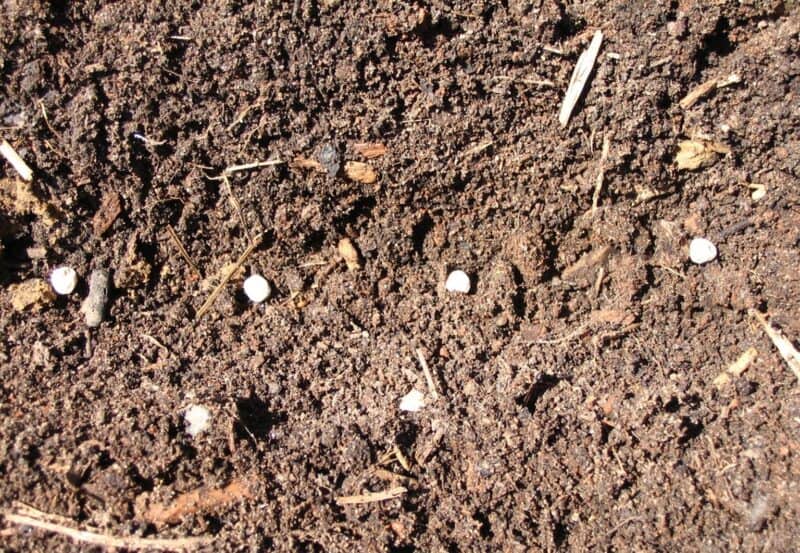
If you’re unsure whether your chosen spot will provide enough sun, try doing a test by placing a card or piece of paper in the location and seeing how long it takes for the sun to reach it.
As for drainage, peas don’t like soggy soil, so it’s best to avoid areas that tend to stay wet after a rainstorm.
What Kind of Soil Do Peas Like?
Peas are a type of legume, and like all legumes, they have a symbiotic relationship with nitrogen-fixing bacteria.
This means that they are able to convert atmospheric nitrogen into a form of nitrogen that can be used by plants. As a result, peas need less nitrogen than other types of plants.
In terms of soil, this means that peas do not need rich soil in order to thrive. In fact, peas can actually do quite well in poor soil as long as it is well-drained. The ideal soil for growing peas is loose and crumbly with a pH between 6.0 and 7.0.
If your soil is heavy or clayey, you can improve its drainage by adding some organic matter such as compost or peat moss.
Saving Pea Seeds
To save seeds each season, simply allow the vegetables to fully ripen and then dry completely on the vine. Then you can put them in an envelope or plastic container and save them to plant next year.
Just be sure you allow them to completely dry and remain dry throughout the winter, or they will mold before you get the chance to plant them.
Growing Peas: How to Care for These Edible Pods After Planting
After you have planted your peas, it is important to care for them properly in order to ensure a bountiful harvest. Peas are relatively easy to grow, but they do require some specific care.
How Often to Water Peas
Try to water at least once a week, but when you water, do so deeply. The soil should never be totally dry, as this can reduce pod production. Watering too much, however, can cause fungal growth.
Fertilizing Peas
Peas don’t require any fertilizer, and actually can add nitrogen back into the soil. Too much nitrogen can cause the plants to produce lush foliage but very few harvestable pods.
A good idea, however, is to provide a legume inoculant. Many nurseries and greenhouses that sell seeds already do this. Peas have a symbiotic relationship with crucial bacteria.
To inoculate your own seeds with these bacteria, simply soak them overnight and then sprinkle an inoculant powder over them just before you plant. This will help them set more fruit and be healthier plants overall.
Rotating and Trellising Pea Crops
I moved my pea trellis to a new bed. You don’t want to plant in the same place as the previous year, or you’ll encourage pests.
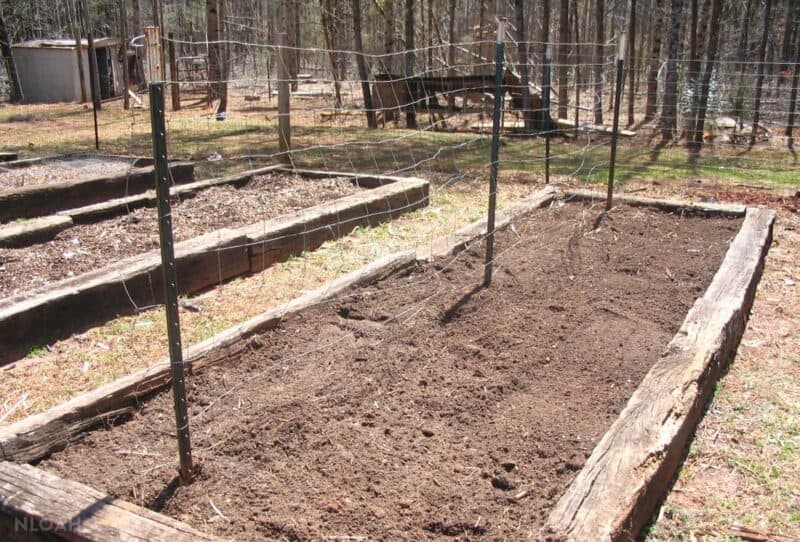
As you can see, my trellis fence is very simple. Just some stakes and wire fencing stretched across each other. It’s 4 ft. tall. Something taller would be ideal, since my pea vines have frequently climbed higher than my trellis.
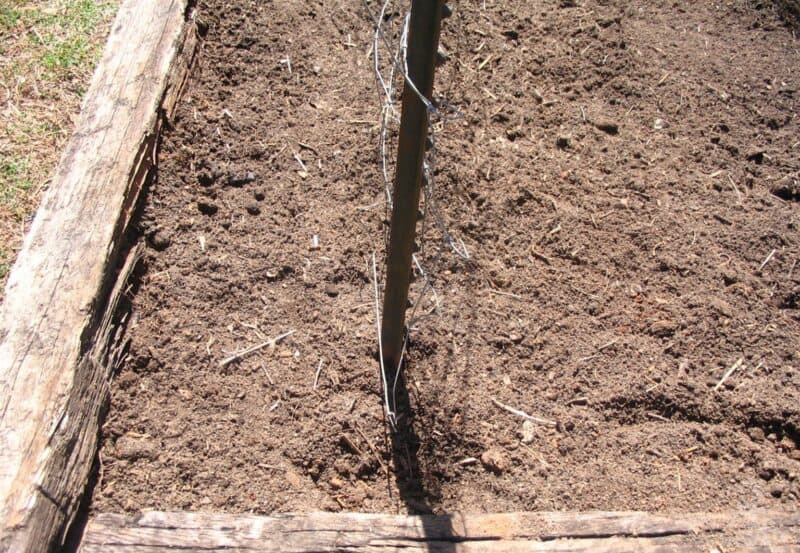
Pests and Diseases
Pea plants are relatively hardy and resistant to pests and diseases, but there are a few problems that can arise. One of the most common is powdery mildew, a white or gray fungus that affects the leaves and stems of the plant.
Other problems include root rot, aphids, and mites. To prevent these problems, it is important to water the plants regularly and to remove any affected leaves or stems as soon as possible.
Aphids are one of the more common pea pests, but they are easy to control by manually picking them off, or spraying them with cold water or insecticidal soap.
Root rot is a serious problem that can affect peas. The roots of the plant become waterlogged and begin to decay. This can happen if the plant is grown in too much water or if the soil is poorly drained. Root rot can also be caused by a fungal infection.
Symptoms of root rot include yellowing leaves, stunted growth, and wilting. The plant may eventually die if the roots are completely rotted away. Root rot can be difficult to control once it has started, so it is important to take preventive measures. Peas should be planted in well-drained soil, and they should be watered only when the soil is dry.
As for mites, these are tiny spider-like creatures that can wreak havoc on your plants. While they are most often found on houseplants, mites can also infect outdoor plants, including vegetables.
Peas are a particularly common target for mite infestations, and these pests can cause serious damage to the plants. Mites feed by piercing the plant’s leaves and sucking out the juices, which can cause the leaves to turn yellow and eventually drop off. In addition, mites produce a webbing that can cover the plant and prevent new leaves from growing.
If you suspect that your peas have mites, it’s important to take action immediately. Remove any affected leaves and sprayed the plant with a strong jet of water. You may also need to treat the plant with an insecticide.
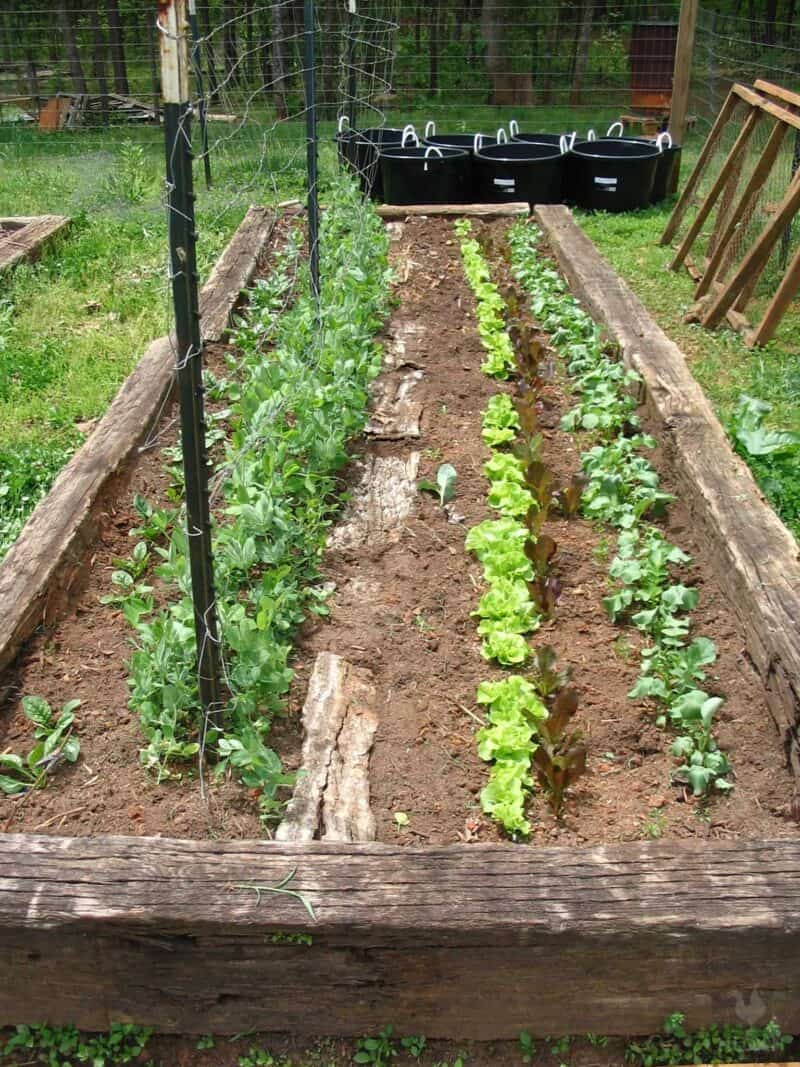
Pea Companion Plants
I like to leave space on both sides of the trellis for planting peas. On the far left, up against the edging I’ve planted spinach; this is a great companion plant for peas.
Closer to the trellis, I have peas planted on either side of the fence. Pea plants grow best with some support, and are given to rot if not given something to crawl along.
You don’t have to use an official, store-bought trellis.
Consider planting your peas with corn so that they can wind themselves around the stalks, or interlace twine between posts. You can even use broken sticks or stakes as makeshift trellises.
It is important to note that not all plants benefit from being planted next to peas. In fact, some plants, such as beans and spinach, actually compete with pea.
Therefore, when choosing companion plants for peas, it’s important to select plants that are known to be heavy nitrogen users, such as tomatoes and potatoes.
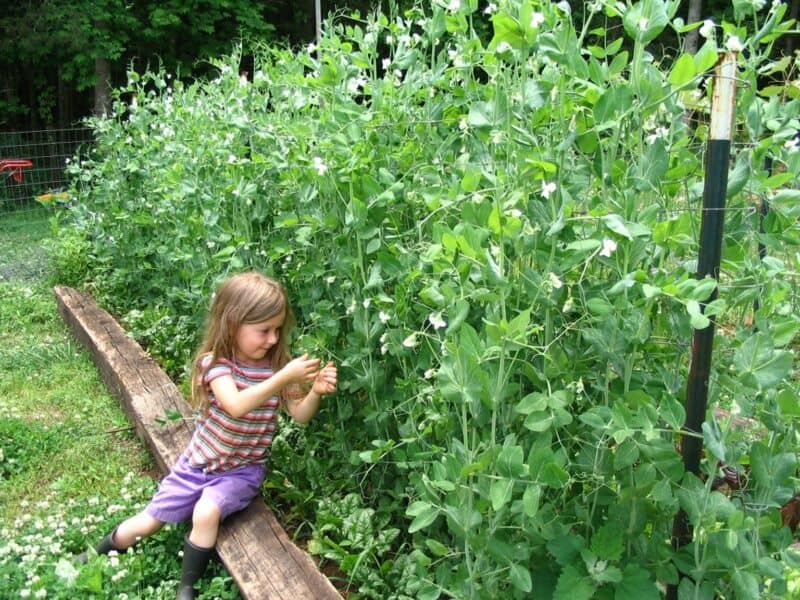
Harvesting Peas
Peas are fun! Because the seeds are so big, they’re easy for children to handle.
When Xia asked if she could please help me plant them, I was more than happy to dump a handful of pea seeds in her little palms and let her go at it. I can’t wait to see her excitement when the seedlings begin to emerge!
To harvest peas, first check to make sure that the pods are round, shiny, and bright green. Anything else indicates that they are either over- or under- ripe.
Peas are the most delicious when the pods have some movement around the peas. Pick the pods by using both hands to pinch the pods away from the vine.
Try not to pull too hard, as peas have delicate root systems and can easily be extracted by mistake. Try to harvest every day or every other day so that you can be sure to harvest fresh peas, and to encourage the plants to continue producing.
How to Use Peas
I don’t expect to have enough peas to can or freeze, but we don’t really eat cooked peas that often anyways. The children love picking fresh peas off the vine best, so as long as we have enough for grazing we’ll be happy. However, if you choose to preserve peas, there are a number of options in doing so.
You can freeze peas immediately after harvest, but be sure to blanch to help them preserve their taste. They will lose some texture, but are still delicious steamed or in soups.
Peas can also be dried by placing them in a dehydrator, but they become a bit starchy throughout this process.
I planted the rest of the bed with carrots, radishes, and leafy greens (spinach, lettuce, cabbage) as they are all good companion plants for peas as well.
I even got fancy and planted red romaine and purple cabbage, so hopefully I’ll get a splash of color in the bed. We’ll see!
Almost ready to harvest:
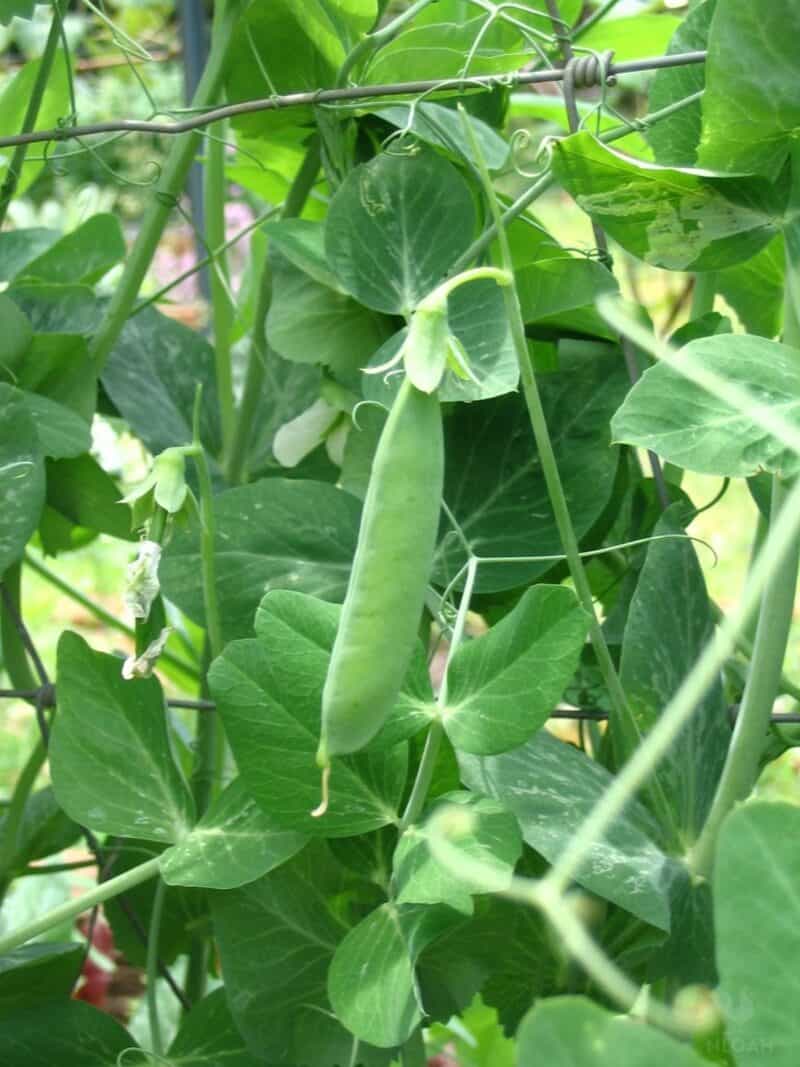
The lettuce, spinach, cabbage, carrots, and radishes have done really well next to the peas. The shade that the vines provide has been a real bonus on the hottest days. I’m thinking I found a new favorite planting combo here!
How Long Do Peas Take to Grow?
The answer to this question depends on a number of factors, including the type of pea, the climate, and the growing conditions. In general, however, most peas will be ready to harvest within two to three months.
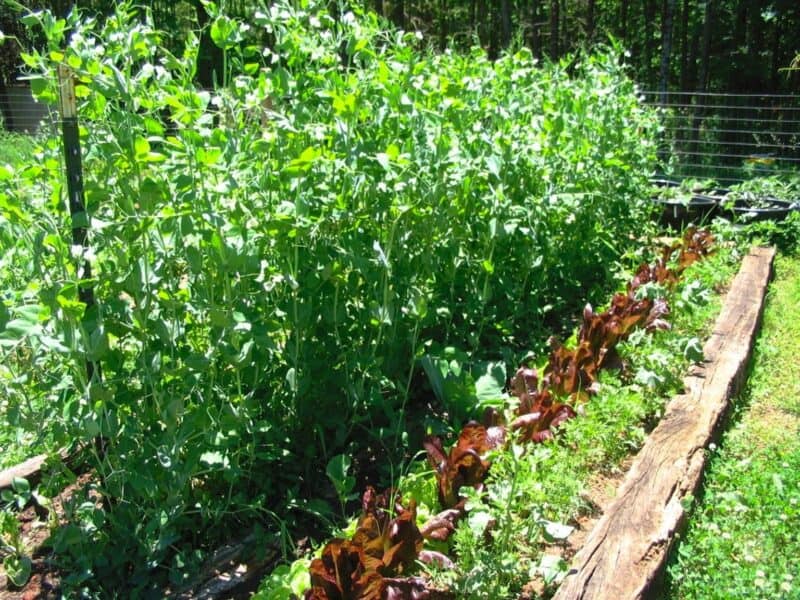
Early varieties may be ready in as little as six weeks, while later varieties may take up to four months. Peas are a cool-weather crop, so they can be planted as soon as the last frost has passed.
In warm climates, they can also be planted in late summer to have germination in time for a fall harvest.
Here’s the raised bed when the plants were still young:
But a tiny few of my harvested peas:
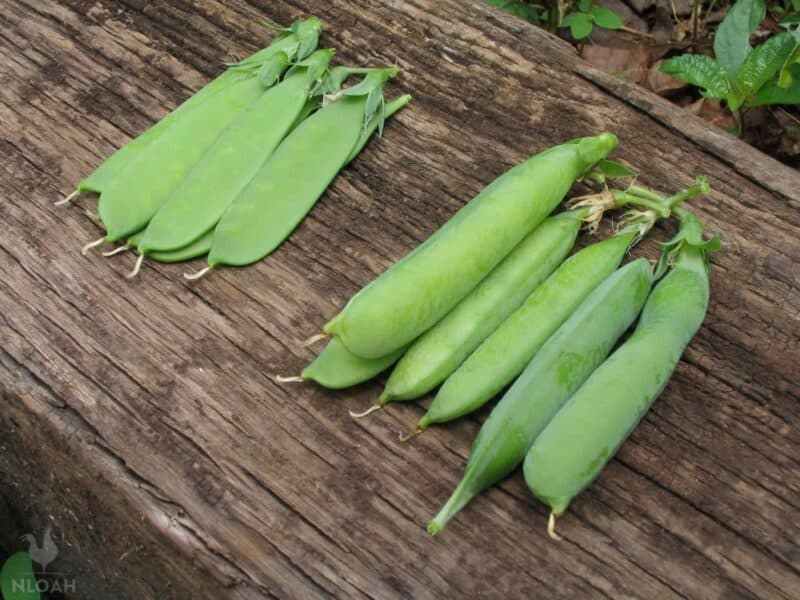
Do you plant peas differently? Any special tips to share?
Growing Peas FAQ
Soak the seeds in water for 24 hours. This will help them to germinate more quickly once they are planted.
Peas are a cool-weather crop, and they will not do well if the temperature gets too warm. In regions with long growing seasons, it is possible to plant a second crop of peas in late summer for a fall harvest. However, in most cases, the spring crop will yield the best results.
Peas are climbing plants and need some type of structure to climb on. While there are many commercially-available trellises on the market, it is also possible to build your own homemade trellis using materials that you may already have around the house.
For example, you can use garden stakes and string to create a basic frame, or repurpose an old ladder or clothesline as a sturdier option.
Garden peas are a cool weather crop that is typically planted in early spring. Peas need about 60 days to mature, but they can be harvested a few weeks earlier if you are willing to sacrifice some size and sweetness.
To ensure a continuous harvest, plant a new batch of peas every two weeks from late winter until early spring.
When harvesting peas, it is important to pay attention to the pods. Pods that are plump and green are ready to be picked, while those that are yellow or brown should be left on the plant. Once the pods begin to dry out and shrivel, the peas inside are no longer edible.
To ensure a steady supply of fresh peas throughout the season, it is best to plant several different varieties that will mature at different times.
Peas are a type of legume, and like all legumes, they contain a high amount of nitrogen. This nitrogen is essential for plant growth, but it can also be harmful if it isn’t properly managed.
When peas are dried, they lose a lot of their water content. This means that the concentration of nitrogen increases, which can make it difficult for the plants to absorb the nutrient.
As a result, it is possible to grow pea plants from dried peas, but it takes some care and attention to ensure that the plants get the nutrients they need to thrive.
One of the most common reasons why peas fail to produce flowers is lack of sunlight. Peas need at least six hours of direct sunlight per day in order to bloom. If they are not getting enough light, they will produce leaves but no flowers.
Another possible reason for flowerless peas is temperature. Peas prefer cooler temperatures and will not bloom if the weather is too hot.
Also, if the plants are stressed from pests or poor nutrition, they may also fail to produce flowers. If you are having trouble getting your peas to bloom, check to make sure that they are getting enough sunlight and that the temperature is cool enough. You may also want to try improving their nutrition by adding compost or organic fertilizer to the soil.

A city girl learning to homestead on an acre of land in the country. Wife and homeschooling mother of four. Enjoying life, and everything that has to do with self sufficient living.

I grew peas, but I never grow enough of them! I’ve noticed that when you leave them past their season, even if they look like they’re going to die, they sprout and try to produce again. But the flavor won’t be the same, will it?
Hello Kendra, It’s been a long time since I visited. I can see your seed beds look wonderful… soooo much better than the first year you planted. I remember how dry and red the soil was and wondered if anything would come up. Wow!! what a difference. Looks like you made lots of progress on the homestead. Good work!
Hi Mrs. D!! It’s good to hear from you. Yes, it seems the garden gets a little better each year. Putting in raised beds has really made a huge difference for us, especially with this red clay dirt we have here. Moving forward, a little at a time 🙂
i have planted peas for years and i still enjoy reading what other gardeners say who know you might learn something new, thanks
We soak our pea and bean seeds for 24 hours before planting. We also put a bit of inoculant in a brown paper bag and toss the seeds around in it…we always have a wonderful crop of both the peas and the beans. I like your pea fence…very nice.
Kendra, I love your website, visit it often now that I have found it. I am going to do raised beds for the first time this year and go 100% organic. I also ordered all organic/heirloom seeds from Baker Creek as well. My question is what type of wood did you use for your raised beds? God Bless.
Kim Parker,
We’re using old railroad ties. I understand there is a lot of controversy around using railroad ties. I figure if they’re old (with termite damage like ours), and aren’t oozing black goo, the creosote has probably leached out already for the most part. I lined a few of our beds with black plastic to create a barrier between the ties and the soil, just as a precaution. I like railroad ties because they’re easy, cheap, and effective.
Is that your little Xia? My goodness, it seems like she was just born and now she’s old enough to help in the garden!
Sounds like you have a great start to your garden! Enjoy!
Tell me about it, Daisy!! She’ll be 5 in July. Crazy.